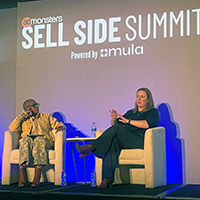The man, the myth, the legend. To black hat SEOs he embodies the dreaded arch enemy. To white hats, he is the source for authoritative, accurate advice you can trust.
My feelings toward Matt Cutts were always somewhat ambivalent (he seemed like a cool guy but I lumped much of his advice into the “how it should be done” category)–until I attended PubCon Las Vegas where he was the one who stuck up for the small site owners against the SEOs that bashed them. I really respected and appreciated that. I have read his blog for (guessing here) at least a year and enjoy it very much. For some reason, perhaps due to my success in late 2003 and early 2004 in promoting sites using “questionable” techniques such as purchasing unrelated links and using programs like the Digital Point Coop, I read Matt’s blog but I never really let myself accept or fully listen to what he was saying. Much of his advice I brushed off, thinking “of course this is what a Google employee would say.”
The result? As a fresh college graduate I was scrambling to get some sites online earning money through AdSense or affiliate programs. I never participated in truly spammy techniques like cloaking or scraping, but the sites I was creating were not providing anything truly unique or enlightening. Researching and devoting days to building legitimately useful sites sounded like a lot of work—and who wants to work? ![]()
These sites, promoted by purchased links, directories and article submissions received a ton of traffic from MSN and to a lesser extent Yahoo. This traffic converted well with affiliate programs but was essentially useless with AdSense. Perhaps this is because I am fairly new to AdSense and failed to approach things correctly—I’m not sure. One thing was certain, though: I was getting little or no traffic to these new sites from Google, and AdSense didn’t seem to like the traffic I was getting.
Was I surprised? No, at least not by the minimal traffic from Google. My head was so stuffed with terms like the “sandbox” that I never expected to get quick traffic from Google. I did, deep inside myself, have doubts about any sandbox. A straight sandbox wouldn’t make sense—there are lots of valuable, quality sites that are also new, and Google is too smart to ignore those sites. This is why I am skeptical of strictly defined sandboxes or age filters.
If there is no sandbox or age filter, then why are so many webmasters experiencing effects consistent with such controls? It’s a good question, and the answer (this is all opinion) is a subtle one. My hypothesis, that appears to have been correct based on my own current projects, was that the “TrustRank” concept that had begun to enter the SEO consciousness was very real. My definition of TrustRank is a PageRank-like metric (although we cannot see it in our toolbars) that is only negligibly affected by the quantity or PR of incoming links. Instead, this invisible Trust Rank is developed by the attainment of truly relevant, natural and authoritative links. Nothing new here—we’ve all heard this a thousand times before. I was reading similar explanations as far back as a year ago.
The more I contemplated the TrustRank concept as SEOs were discussing it, the more I realized that what we were now referring to as TrustRank was really a moniker that embodied all the advice Matt had relentlessly poured on deaf ears. Still, as SEOs, most of us didn’t think of it like that. Most of us, biased by years of simple metrics, believed we’d derived the “new, new thing:” TrustRank. My point is this: If we step back and consider the concept of TrustRank objectively it is really nothing new or innovative. It’s just what Google has been telling us all along. Why is it a big deal now, then? Because Google is getting better each day. Many of the best programming minds in the world call the GooglePlex home. In the end, they are going to win. The algorithm they develop will reward sites that do what they want and penalize (or at least neglect) those that do not. Matt Cutts, then, can really be thought of as the voice expressing the direction of Google’s TrustRank, or algorithm in general.
Does this mean blackhat SEO doesn’t work? Of course not. I know tons of guys getting richer each day from blackhat sites. But I will say that blackhats are fighting an uphill battle. They are essentially attempting to outdo the collective accomplishments of many of the brightest minds in the world.
With these feelings in mind, I finally acquiesced. I decided to ditch my routine of throwing up medium to low quality sites. In the end, I was working my ass off trying to build links (when your site is nothing special, as some of you surely know, it is hard work getting links that matter). It would almost be easier, I concluded, to just do what Matt advocated and create something truly useful and innovative. Even if it were a bit more difficult, I was confident it would stand the test of time.
While I don’t feel comfortable disclosing the URL of my latest project on this blog, I will say that I have been personally (along with a friend I convinced to join me) slaving away developing what is genuinely a useful resource. I am three days nigh of the two month anniversary of the site’s creation, and I’m getting approximately 1,000 unique visitors a day and over 5,000 page views from Google alone.
To me, those results are testament to the invalidity of a sandbox. I was careful in my construction of this project and every time I considered adding a new section, page, or feature, I stopped myself and thought “What would Matt think about this?” In my mind that question is synonymous with “What would Google think about this?” If the answer was “He’d like it,” I would proceed. Otherwise, I’d think of something else.
It seems to be working. I can say that the last time I had a site getting this kind of traffic from Google alone, this quickly, was in early 2004. The only concern I have, after attending PubCon Las Vegas, is that my questionable past may come back to haunt me. During the site review panel Matt was involved in, he asked one of the victims who had submitted his site for review why he had so many domains he wasn’t using. Google is a domain registrar that doesn’t sell domains. The only purpose of this I am currently aware of could be to find out who owns what domains. I’m no expert on the intricacies of the domain registration system, but I am under the impression that registrars (like Google) have no problem seeing through private registrations. I know there are a few domains in my portfolio that Matt wouldn’t be too fond of and I really hope these do not negate my new whitehat efforts.
Please don’t take this as an attack on blackhats. I find the blackhat world exceedingly interesting and, by virtue of its competitiveness, fun. But in the long run, I have accepted blackhat defeat. If I want to make money from a site in the long run I am going to continue to ask myself “What would Matt think of this?”
*A comical side note is that the site mentioned above is getting less than 5-10 visitors a day from MSN and Yahoo combined as opposed to approximately 1,000 from Google. What a reversal from the norm! ![]()
BTW: Because I’m enjoying my blogging experience so much due to the readership and comments, please let me know if you disliked this post. I can stick with event coverage if my SEO writings are lackluster ![]() Don’t want to scare anyone away…
Don’t want to scare anyone away…



